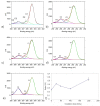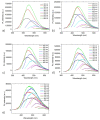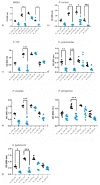Employing Gamma-Ray-Modified Carbon Quantum Dots to Combat a Wide Range of Bacteria
- PMID: 37237822
- PMCID: PMC10215299
- DOI: 10.3390/antibiotics12050919
Employing Gamma-Ray-Modified Carbon Quantum Dots to Combat a Wide Range of Bacteria
Abstract
Nowadays, it is a great challenge to develop new medicines for treating various infectious diseases. The treatment of these diseases is of utmost interest to further prevent the development of multi-drug resistance in different pathogens. Carbon quantum dots, as a new member of the carbon nanomaterials family, can potentially be used as a highly promising visible-light-triggered antibacterial agent. In this work, the results of antibacterial and cytotoxic activities of gamma-ray-irradiated carbon quantum dots are presented. Carbon quantum dots (CQDs) were synthesized from citric acid by a pyrolysis procedure and irradiated by gamma rays at different doses (25, 50, 100 and 200 kGy). Structure, chemical composition and optical properties were investigated by atomic force microscopy, transmission electron microscopy, X-ray photoelectron spectroscopy, Fourier transform infrared spectroscopy, Raman spectroscopy, UV-Vis spectrometry and photoluminescence. Structural analysis showed that CQDs have a spherical-like shape and dose-dependent average diameters and heights. Antibacterial tests showed that all irradiated dots had antibacterial activity but CQDs irradiated with dose of 100 kGy had antibacterial activity against all seven pathogen-reference bacterial strains. Gamma-ray-modified CQDs did not show any cytotoxicity toward human fetal-originated MRC-5 cells. Moreover, fluorescence microscopy showed excellent cellular uptake of CQDs irradiated with doses of 25 and 200 kGy into MRC-5 cells.
Keywords: antibacterial activity; carbon quantum dots; cellular uptake; gamma rays.
Conflict of interest statement
The authors declare no conflict of interest.
Figures








References
-
- Pinna D. Microbial growth and its effects on inorganic heritage materials. In: Joseph E., editor. Microorganisms in the Deterioration and Preservation of Cultural Heritage. Springer; Cham, Switzerland: 2021.
-
- Clause C.A. Bacterial associations with decaying wood: A review. Int. Biodeter. Biodegr. 1996;37:101–107. doi: 10.1016/0964-8305(95)00109-3. - DOI
-
- Li W., Zhang Y., Wu N., Zhao Z., Xu W., Ma Y., Niu Z. Colonization characteristics of bacterial communities on plastic debris influenced by environmental factors and polymer types in the haihe estuary of bohai bay, China. Environ. Sci. Technol. 2019;53:10763–10773. doi: 10.1021/acs.est.9b03659. - DOI - PubMed
Grants and funding
LinkOut - more resources
Full Text Sources
Molecular Biology Databases

